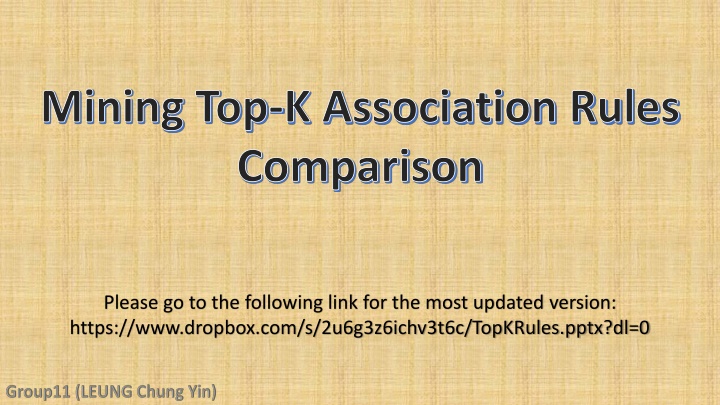
Efficient Comparison of Top-K Association Rules in Mining
Discover the efficient way to compare and analyze the top-K association rules in the field of data mining. Explore the challenges in traditional methods and learn about the innovative approach of TopKRules for generating rules effectively.
Download Presentation

Please find below an Image/Link to download the presentation.
The content on the website is provided AS IS for your information and personal use only. It may not be sold, licensed, or shared on other websites without obtaining consent from the author. If you encounter any issues during the download, it is possible that the publisher has removed the file from their server.
You are allowed to download the files provided on this website for personal or commercial use, subject to the condition that they are used lawfully. All files are the property of their respective owners.
The content on the website is provided AS IS for your information and personal use only. It may not be sold, licensed, or shared on other websites without obtaining consent from the author.
E N D
Presentation Transcript
Mining Top-K Association Rules Comparison Please go to the following link for the most updated version: https://www.dropbox.com/s/2u6g3z6ichv3t6c/TopKRules.pptx?dl=0
Once upon a time Philippe Fournier-Viger1 Cheng-Wei Wu2 Vincent S. Tseng2
Traditional way Difficult to set minsup 0.1: No Rules Found 0.1: >10000 Rules
Traditional way 1.Find Frequent Itemsets 2.Find Association Rules using frequent itemsets (Another Big Task) Ex. ABCD is frequent A BCD, B ACD, AB CD, AC BC, Store every count? Exponential!
TopKRules (Idea) 1.Scan DB: Record each item s tidset (Set of transaction ID) 2.Gen Base Rules r into L 3.Loop all rules in L LeftExpansion RightExpansion Until L is empty
TopKRules (Base) Items: A, B, C, D Base Rules (Totally 4C2 = 12): A B, A C, A D, B C, B D, C D, B A, C A, D A, C B, D B, D C
TopKRules (Base) Record 2 things: tidset(A) tidset(B) tidset(A) (Covered Transactions) (Evidenced Transactions) Count Support Efficiently
TopKRules (Left Expansion) distinct item c from covered transactions in Rule A If c RHS AND c > all items in LHS Then put A {c} {c} B to L B
TopKRules (Right Expansion) distinct item c from covered transactions in Rule A If c LHS AND c > all items in RHS Then put A B {c} {c} to L B
TopKRules (Duplicated Rules) Duplication Examples: A C A C Left Expand Right Expand AB C A CD left Expand Right Expand AB CD AB CD
At the same year Philippe Fournier-Viger1 Vincent S. Tseng2
1. AB 2. AB 3. A C CD CD
1. AB 2. AB 3. A C CD CD Most Items Least Items
TNR TopK Non-redundant Rules
TNR (Strategies) TopKRules
TNR (Case1) TopKRules
TNR (Case2) TopKRules
TNR (Case2) New Parameter k = k +
TNR (Case2) If # of Case2 > Then it is Approximation
Results 1. TR is very fast, full of redundant 2. TNR is slow, no redundant 3. Never get a good 4. For k>2000, TNR is super slow. 5. Acceptable RAM usage
ATNR Approximate TopK Non-redundant Rules
Limitations Measures Limited: Lift/Interest/Gini
Very Similar Papers 2015 IJIRT | Volume 1 Issue 12 | ISSN: 2349-6002: TECHNIQUE FOR MINING TOP-K ASSOCIATION RULES http://www.ijirt.org/vol1/paperpublished/IJIRT102265_PAPER.pdf 2016 IJETST- Vol.||03||Issue||01||Pages 3491-3500||January|| ISSN 2348-9480: An Efficient Algorithm to Mine Non Redundant Top K Association Rules http://dx.doi.org/10.18535/ijetst/v3i01.12
